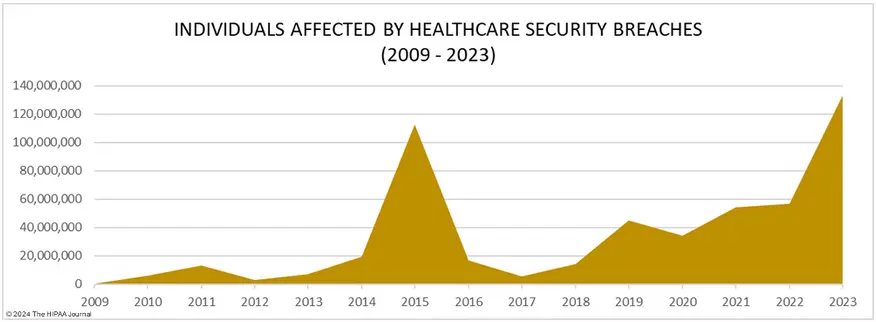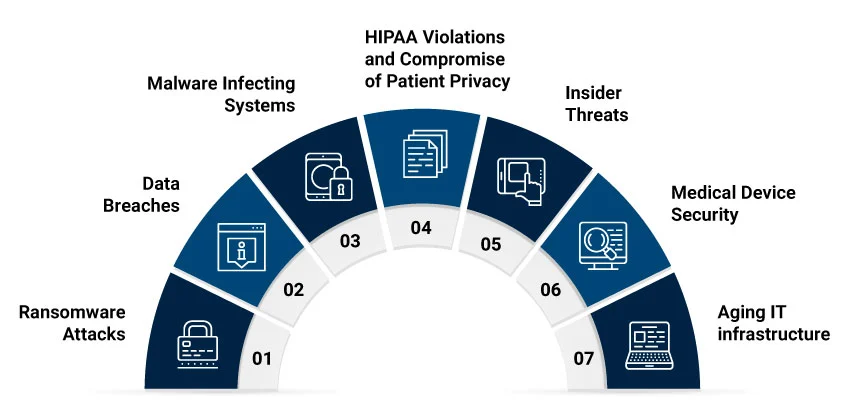June 28, 2024 - by Synoptek
124 million Healthcare Records Breached in 365 Days in 2023! This February, just one ransomware attack on a company called Change Healthcare compromised about 85 million patient records, and recovery is still in progress. Due to this single attack, patients continue to face delays in testing and critical medical procedures as healthcare operations are disrupted.
The HIPAA Journal reported that healthcare data breaches alone accounted for 93.5% of all breached records in the last year.
Healthcare data breaches averaged $10.93 million in costs, significantly higher than the second-in-line financial industry’s average of $5.9 million. The severity of these breaches underscores the need for robust healthcare cybersecurity measures.

Source: The HIPAA Journal
Current Landscape of Healthcare Cybersecurity
The healthcare industry faces significant challenges in addressing sophisticated cyberattacks, often due to exploiting previously known vulnerabilities. Many healthcare organizations struggle to implement basic security measures and adhere to cybersecurity best practices due to budget constraints, talent shortages, and poor knowledge about effective resilience strategies.
Here are the key impacts and challenges that highlight the urgency of this issue:
- Patient Care Disruption: Ransomware attacks can cause procedural delays, leading to poor outcomes and patient mortality.
- Data Exposure: Cyberattacks can expose sensitive patient health records and payment card data, putting patients at risk of identity theft and financial fraud.
- Operational Disruption: Distributed Denial of Service (DDoS) attacks are also a growing threat, potentially bringing healthcare systems down and impacting critical care and patient treatment.
Key Threats in Healthcare Cybersecurity
The healthcare industry faces various cybersecurity threats that can compromise patient care, data security, and organizational operations. Healthcare organizations operate with thin margins, making investing in cybersecurity measures and recovering from financial impacts complex. Also, healthcare has an apparent shortage of cybersecurity skills, making resolving vulnerabilities efficiently and defending critical systems challenging.
Most organizations also lack a well-documented cybersecurity policy, which can easily lead to delayed or fragmented cyber-attack responses.

Here are some of the critical threats or cyber-security challenges that healthcare organizations must address:
- Ransomware Attacks: Ransomware remains the biggest cybersecurity threat in the healthcare industry. According to research, 64% of healthcare IT professionals are concerned about their vulnerability to ransomware attacks, with 77% experiencing between 1 and 5 ransomware attacks over the past two years. The disruption caused by ransomware attacks can lead to downtime, impact patient care, and cause financial losses.
- Data Breaches: Healthcare organizations are prime targets for data breaches, with an average of 373,788 records breached every day. Cybercriminals seek to steal sensitive patient information, such as social security numbers, credit card details, and medical records, which can be sold on the dark web.
- Malware Infecting Systems: Malware can infiltrate healthcare systems through various vectors, such as phishing emails, compromised websites, or infected medical devices. Once inside the network, malware can steal data, disrupt operations, and provide a foothold for further attacks.
- HIPAA Violations and Compromise of Patient Privacy: Noncompliance with HIPAA regulations can lead to hefty fines and reputational damage. Cybersecurity gaps can expose protected health information (PHI) to unauthorized access, risking patient privacy.
- Insider Threats: Malicious or negligent insiders, such as disgruntled employees or contractors, can compromise healthcare data and systems. Insider threats are the leading cause of data loss and exfiltration.
- Verizon’s Data Breach Investigations Report 2024 suggests that insiders cause 70% of healthcare data breaches. Mitigating insider threats requires implementing robust access controls and monitoring user activities.
- Medical Device Security: Connected medical devices that lack robust security measures can serve as entry points for attackers to access healthcare networks. Threats against medical devices can lead to patient safety issues and enable further attacks on other network devices.
- Aging IT Infrastructure: Legacy systems and outdated software are vulnerable to exploitation by cybercriminals. Modernizing IT infrastructure and ensuring regular updates and patches are essential to mitigate risks associated with aging systems.
To address these threats, healthcare organizations must adopt a comprehensive cybersecurity strategy that includes risk assessments, implementation of security frameworks, staff training, and continuous monitoring and improvement of security measures.
Strategies for Building Healthcare Cybersecurity Resilience
Organizations must adopt a comprehensive approach to building resilience to address increasing threats and challenges in the healthcare industry ecosystem. Here are key strategies to consider:
Risk Assessment and Risk Appetite Definition
Conduct regular risk assessments to identify vulnerabilities and potential threats to your organization. Define your risk appetite, which will guide your cybersecurity strategy and investments.
Cybersecurity Frameworks and Best Practices
Adopt industry-recognized cybersecurity frameworks such as NIST CSF, ISO 27001, or HIPAA Security Rule to establish a baseline for your security measures. Implement best practices like access controls, encryption, and regular software updates.
Healthcare Cyber Threats Awareness
Stay informed about emerging healthcare sector cyber threats, such as ransomware, data breaches, and DDoS attacks, and understand their potential impact on patient care and data security.
Security Controls and Incident Response Plans
Implement robust security controls to protect your systems and patient data, including firewalls, intrusion detection systems, and endpoint protection. Develop and regularly test incident response plans to ensure your organization is prepared to respond effectively to cyber incidents.
Staff Training and Awareness Programs
Educate and train employees at all levels about cybersecurity best practices, common attack vectors, and their role in protecting the organization. Build a culture of cybersecurity awareness and accountability.
Cybersecurity Tools and Technologies
Invest in advanced cybersecurity tools and technologies tailored to the healthcare industry, such as medical device security solutions, cloud security platforms, and security information and event management (SIEM) systems.
Collaboration with Cybersecurity Experts and Service Providers
Partner with cybersecurity experts and service providers to access specialized knowledge, resources, and support in addressing complex security challenges. Engage with industry peers, government agencies, and information-sharing and analysis organizations (ISAOs) to share threat intelligence and best practices.
Continuous Monitoring and Evaluation of Cybersecurity Measures
Establish a robust real-time monitoring system to detect and respond to potential threats. Regularly review and enhance cybersecurity protocols based on emerging threats, industry trends, and lessons learned from incidents.
By implementing these strategies, healthcare organizations can build a strong foundation for cybersecurity resilience, protect patient care and data, and maintain trust with patients and stakeholders. However, it’s important to note that cybersecurity is an ongoing process that requires continuous improvement and adaptation to the evolving threat landscape.
Prepare…Predict…Protect Your Patient Data with Cyber-resilience
Protecting data is crucial to humanizing healthcare. Cyberattacks can harm healthcare organizations in multiple ways: financially through ransom demands, reputational damage from compromised data, and disruption to critical healthcare services.
By combining industry knowledge with proactive threat intelligence, our cybersecurity experts enable healthcare players to stay ahead of threats and make healthcare more secure for everyone.



